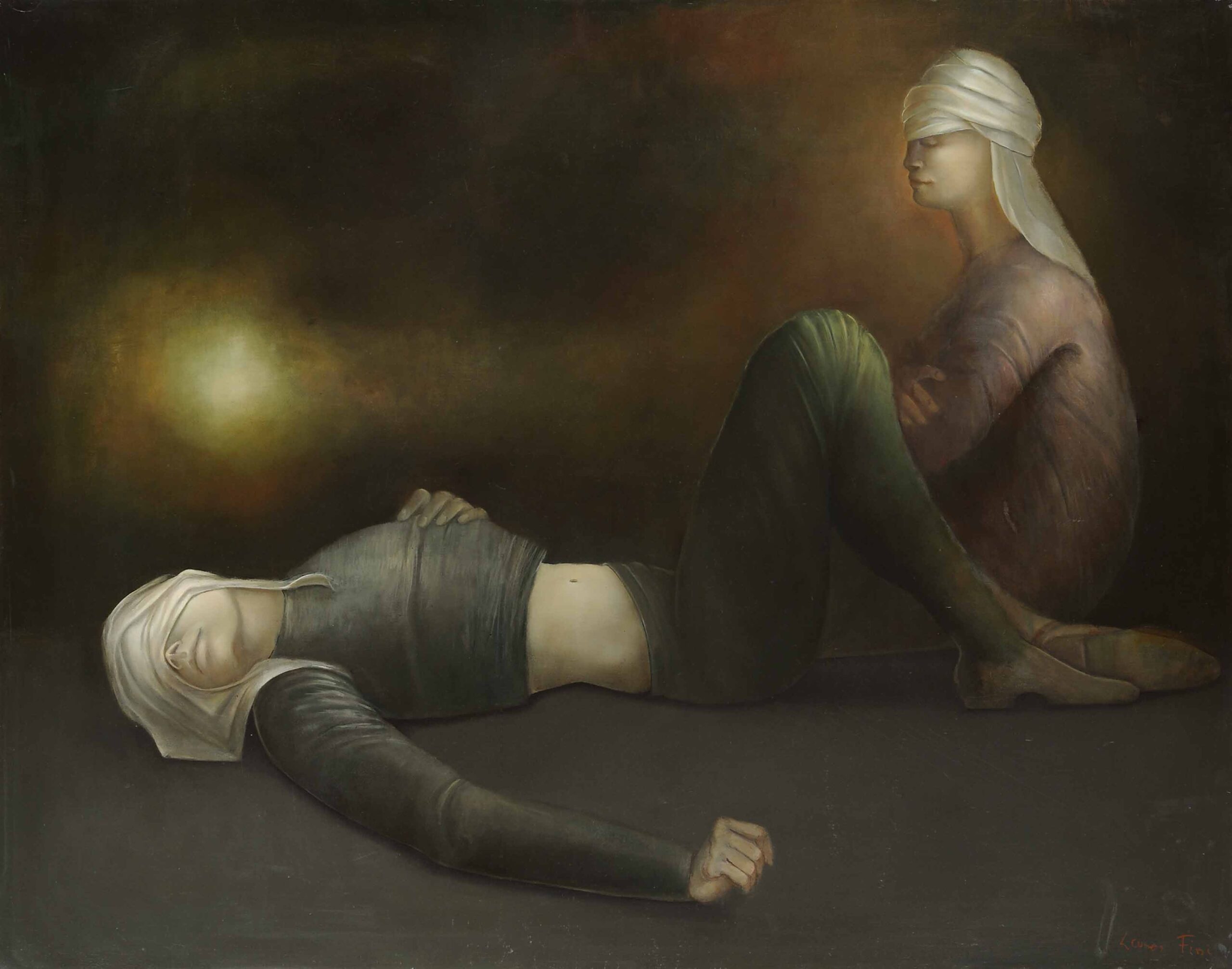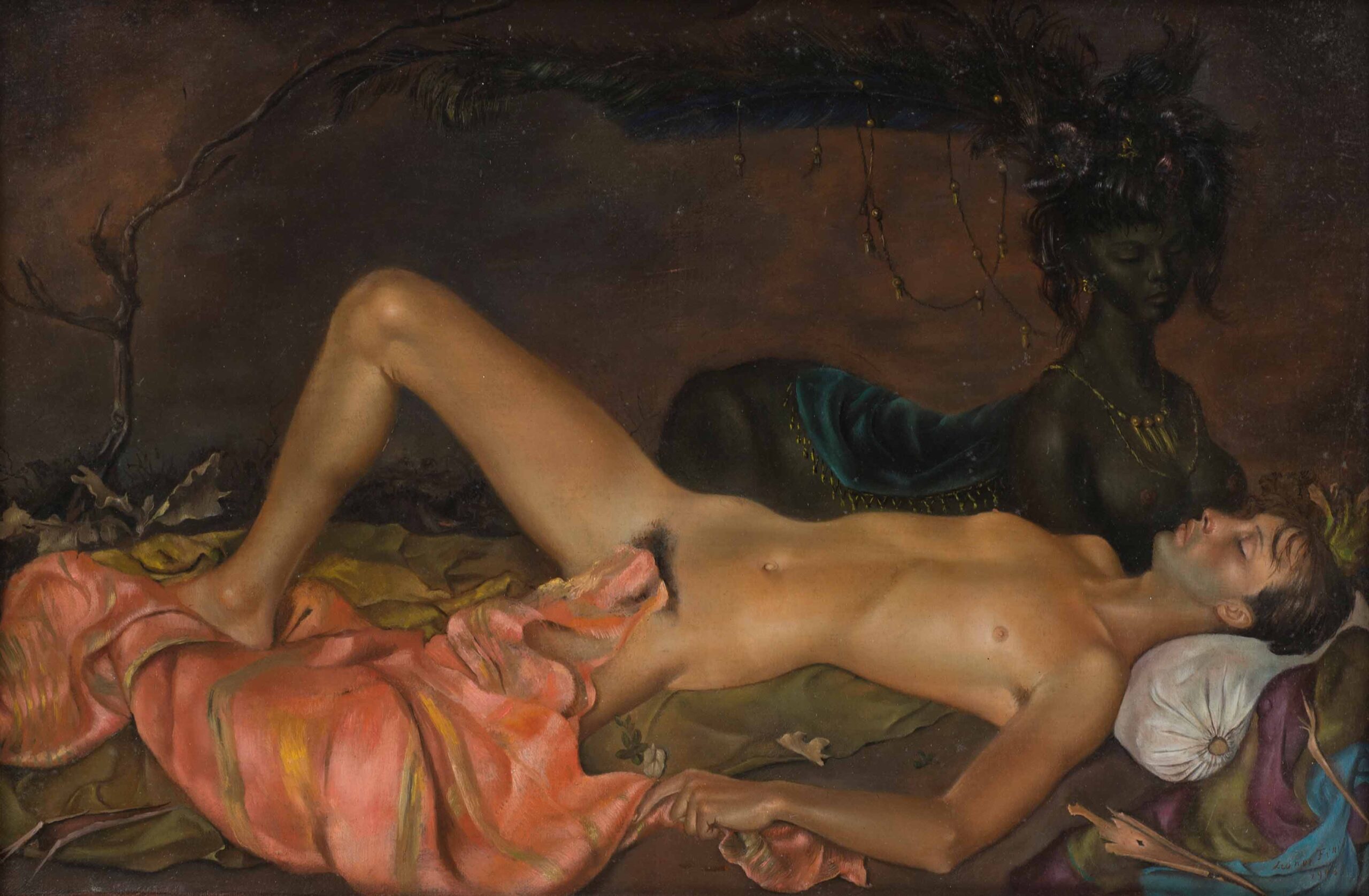
Travellers at Rest
Leonor Fini, 1978, Oil on canvas, Private Collection © Leonor Fini Estate.

Divinità ctonia che veglia sul sonno di un giovane
(Self-portrait with Sforzino Sforza), Leonor Fini, 1946, Oil on canvas, Private Collection © Leonor Fini Estate, Paris.

Travellers at Rest
Leonor Fini, 1978, Oil on canvas, Private Collection. © Leonor Fini Estate, Paris.

Black Sphinx Watching Over the Sleep of a Young Man
(Self-portrait with Sforzino Sforza)Leonor Fini, 1946, Oil on canvas, Private Collection. © Leonor Fini Estate, Paris.
PRIMORDIAL SCENES
Throughout her career, Leonor Fini maintained an ambiguous attitude toward the biographical interpretation of her paintings. While in some statements she rejected the idea promoted by critics and art historians, in others she admitted being unable to resist the temptation of self-representation and confession. This premise opens the exhibition, which presents a selection of emblematic works inspired by Fini’s youthful experiences—episodes that deeply influenced her imagination and repeatedly appear in her work, acquiring the status of conceptual pillars. Representative of this theme are works such as Le Bout du monde (Fée à Beltem) (1953) and Voyageurs en repos (1978).
Scene One: The Sphinx – The Other Self
The sphinx is the creature with which Leonor Fini identifies—an entity that is hybrid, transformative, powerful, and overwhelming. The artist first encountered the sphinx in a pink porphyry sculpture—an original piece from Egypt—preserved in Miramare Castle in Trieste, a city where she had repeated encounters with other allegorical figures, such as caryatids and grotesque masks known as panduri.
As a hybrid creature, both guardian and adversary, the sphinx embodies an ambiguity and complexity that captivated Fini, helping her define her identity as an artist free from conventions and stylistic constraints.
Scene Two: The Helpless Man – Death or Sleep
As a teenager, Leonor Fini visited the mortuary in Trieste, where she had a shocking vision of a deceased body, which she later described as extraordinarily beautiful due to the rich fabrics, collars, and flowers with which its Romani family ritually covered and uncovered it. In Fini’s paintings, the recurring image of sleeping, helpless, seemingly lifeless men—often inspired by traditional depictions of the dead Christ—suggests their subjugation to female power.
Scene Three: Disguise – Masking to Survive
Born in Buenos Aires to an Italian family, Leonor Fini moved to Trieste at the age of two with her mother, an independent woman who introduced her to the city’s intellectual circles, raising her far from her father. It was he who orchestrated an attempt to kidnap young Leonor, who, having escaped her captors, found safety in disguise: dressed as a boy, she roamed the city, an experience that left a lasting imprint on her imagination.
Scene Four: Blindness – An Epiphany
The last of the Primordial Scenes recounts how, at the age of 16 in 1923, Leonor Fini recovered from an eye infection that had left her blind for two and a half months.
Upon "awakening" from this “dream,” she experienced a true epiphany that convinced her to pursue an artistic career. The metaphor of blindness as a gateway to a higher vision became a key tenet of Surrealism, deeply influencing her artistic development.
This experience gave rise to her obsessive dedication to visual perception and an exceptional tactile sensitivity that emerges in her works, evident in the rendering of skin, fabrics, and textures—traits characteristic of someone who has honed other senses due to a temporary loss of sight.
